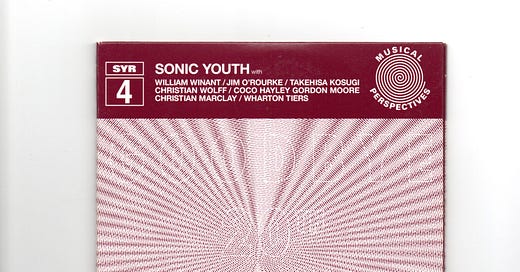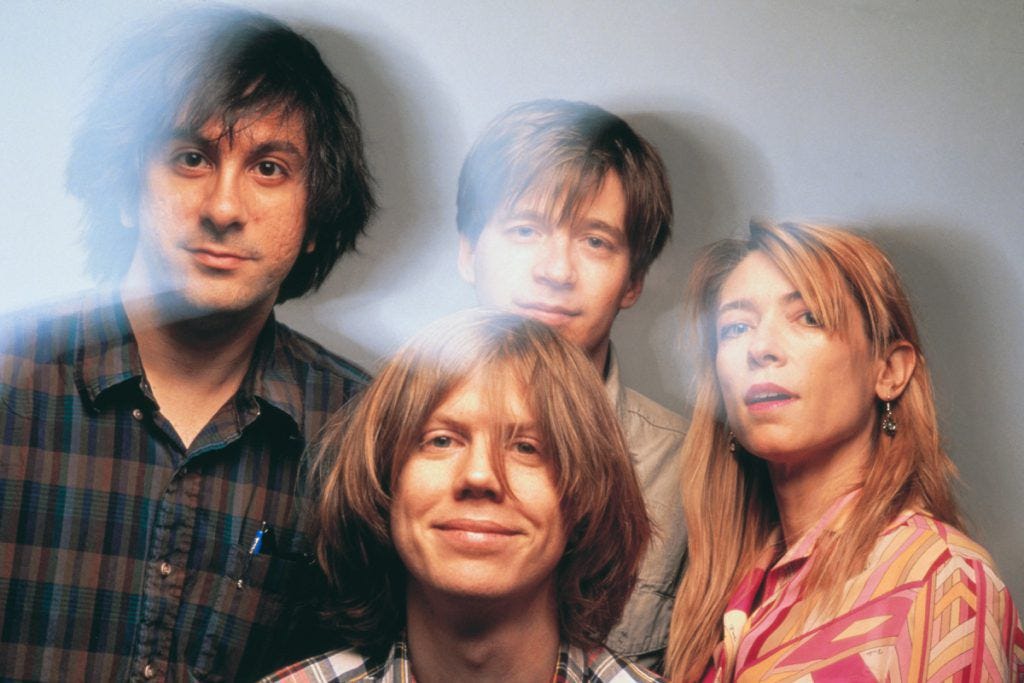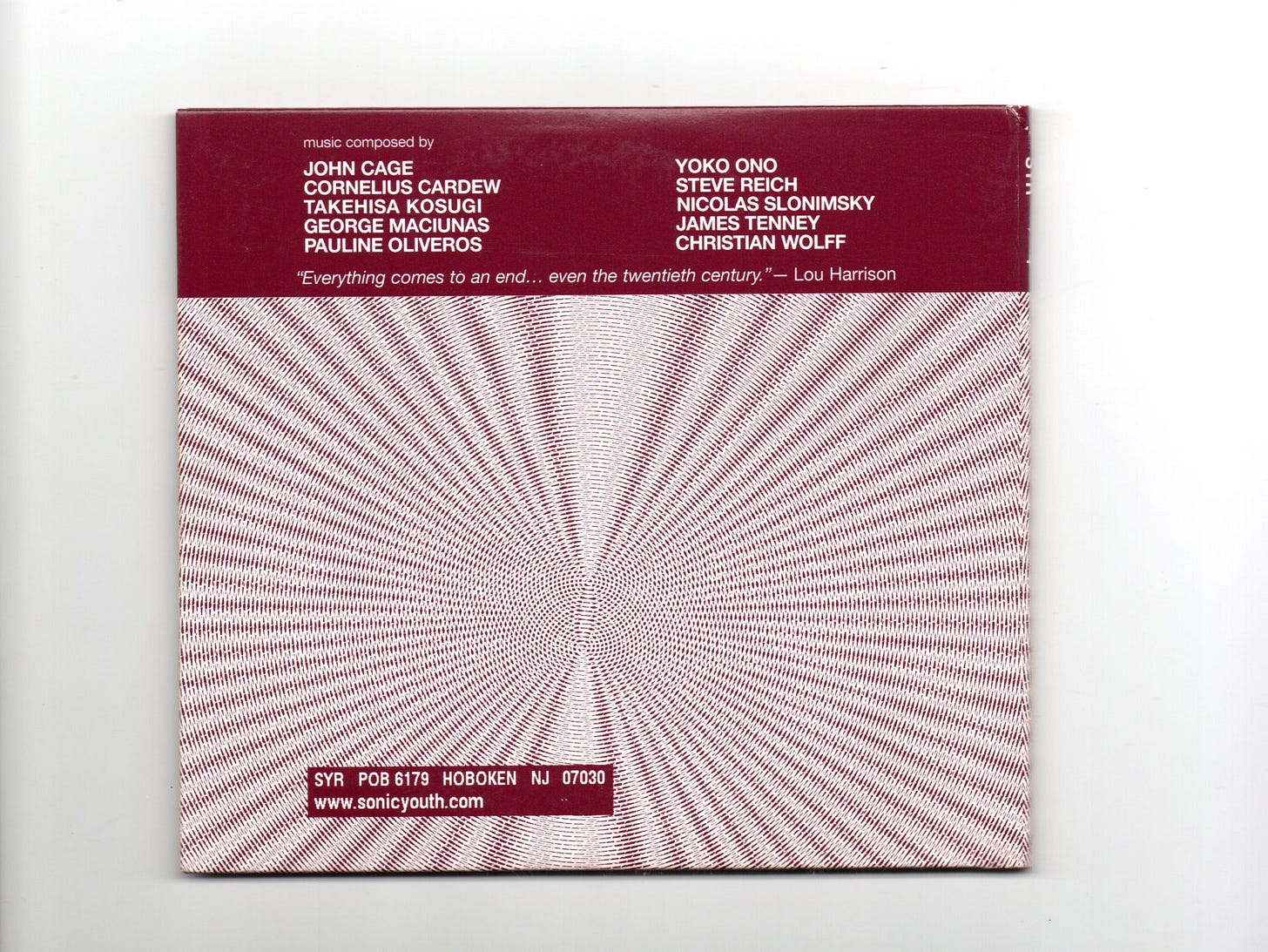Neuguitars 2025 #5: 25 Years of “Goodbye 20th Century” by Sonic Youth
Sonic Youth Record SYR 4, 1999
“Countless sound thinkers have interpreted the music; the point, as Sonic Youth have always maintened, is to change it.”
David Keenan on The Wire Issue 217 March 2002 Pag. 46
On November 22, 2024, Goodbye 20th Century turned 25, celebrating this anniversary with the release of a double LP that includes an insert with notes by Brian Turner. I believe I bought the double CD shortly after its release in 1999, and this anniversary is a great opportunity to write down some thoughts. As I reflect on what to say about it, I’m watching the video where the four Sonic Youth members "perform" Piano Piece #13 (Carpenter’s Piece), composed by George Maciunas for Nam June Paik in 1962. I must admit, it’s quite...striking.
In the video, the four Sonic Youth members take turns hammering nails into the keyboard of an old upright piano. A few minutes later, they walk away from the piano, whose keyboard now resembles a battlefield: wooden splinters everywhere, broken keys, and nails driven in at random. A perfect performance in the Fluxus style, an artistic movement of which George Maciunas was a part. I smile as I read a YouTube comment: “Better than Nicki Minaj,” followed by other reactions, some in agreement, others offering fierce and sarcastic condemnation. The video, uploaded in May 2006, has since garnered over 58,000 views and almost 400 likes.
Sonic Youth,what a fantastic name. It’s a perfect name, and the four of them are exactly the kind of band you’d imagine for a name like that; they make precisely the music you’d expect from a group with such a name, turning their records into true sonic meditations.
Listening to the album, the performance becomes even more unsettling, with the piano groaning under the blows, the sounds of wood and ivory splintering under the hammers, and the nails attacking and destroying the poor piano. I believe Goodbye 20th Century received a similar kind of audience reaction when it was released in 1999. It was a real gamble, a truly courageous project that could have destroyed them—alienating their alternative and indie rock fans and exposing them to accusations of amateurism from proponents of "serious" music.
There were certainly negative reviews ("I remember a caption in a review that just said, 'Goodbye 20th Century, Goodbye Talent.' We pinned it up on the wall of the studio." Jim O'Rourke said, The Wire Issue 213, November 2001, p. 140). However, this album strengthened Sonic Youth's image and earned them the respect of those involved in contemporary art, leading to numerous concert invitations from prestigious art galleries. (Psychic Confusion: La storia dei Sonic Youth by Steve Chick, p. 313)
Credited to Gordon, Moore, Ranaldo, and Shelley, along with numerous guests (William Winant, Jim O'Rourke, Takehisa Kosugi, Christian Wolff, Christian Marclay, Coco Hayley Gordon Moore, Wharton Tiers), this monumental double LP/double CD is a collection of compositions that retraces the 20th century, paying homage to it through free interpretations of contemporary music. Some of the century’s greatest composers were involved, figures like John Cage, George Maciunas, Pauline Oliveros, Steve Reich, Cornelius Cardew, and Christian Wolff. Particularly extraordinary in Goodbye 20th Century is the presence of some of these composers themselves, with Oliveros even composing a piece for the occasion, titled Six for New Time – For Sonic Youth.
The selection of tracks was curated by William Winant ( http://williamwinant.com/ ), a highly regarded percussionist in the field of contemporary music, who had worked extensively with John Cage and collaborated with a range of artists from Frank Zappa to Boulez, the Kronos Quartet to John Zorn. Winant, who is also a childhood friend of Kim Gordon (Girl in a Band, p. 241-242), chose pieces that could be performed by a small ensemble and involved all the musicians participating:
"I knew I’d have to find things that would work with these specific people and their instruments, either as a solo, quartet, quintet, or sextet. I chose graphic scores with open instrumentation and varying degrees of indeterminacy written into them."
—William Winant, Bananafish #13
On one hand, Goodbye 20th Century was a natural continuation of the path started with the albums released through Sonic Youth Records, recorded in their Echo Canyon studio, which created a fitting context for such a project. On the other hand, working alongside so-called avant-garde musicians had always been part of Sonic Youth's normal activity. As Thurston Moore explained in an interview with Daniela Cascella, the choice of composers reflects their desire to "address the liberation of the musician":
"This is an idea that punks believed they had invented. The fact that avant-garde music has always been a major step forward, an expansion, as taught in academies worldwide since the 1950s, is something we need to share with punks everywhere. In reality, that kind of music manages to mix the hippie, the punk, and the academic identity."
(Blow Up, June 2000, “Sonic Youth: La Tradizione del Nuovo,” pp. 70-72)
Despite the particular nature of the music recorded on this double CD, Goodbye 20th Century remains a typically "Sonic Youth" album. It’s not essential for fans of Daydream Nation or Goo, but it’s undoubtedly fascinating for those engaged with Neu Musik. Once the initial perplexity subsides (a rock band interpreting Cage?), Goodbye 20th Century reveals itself as a free artistic digression whose strong sequencing and high-energy music possess an intrinsic aesthetic value. More importantly, it’s a vital testament to how underground rock and academic avant-garde have moved along parallel paths—although few on either side have dared to acknowledge it. The band of Lee Ranaldo, Kim Gordon, Thurston Moore, and Steve Shelley not only had the courage to admit it but also the will to declare that the 20th century is over. Just as with rock, it’s time for change. Perhaps it’s time to bid farewell to utopian experiments and embrace a new, invigorating paradigm: border zones must resume communicating and intersecting, finding balance and a place in this global society that no one seems able to manage. Happy anniversary Goodbye 20th Century.







Great post, as ever. I took my then 9-year-old son Frank to see SY perform pieces from this album at the Royal Festival Hall in London in 2001. Despite my warnings, I suspect he was expecting to hear "100%", "Teenage Riot" and the like (as were many much older members of the audience who kept shouting out requests throughout the show, despite its clear billing). I can't really speak for him, but Frank seemed to love it; he's been making experimental electronica for the last two decades, so maybe it left some imprint!